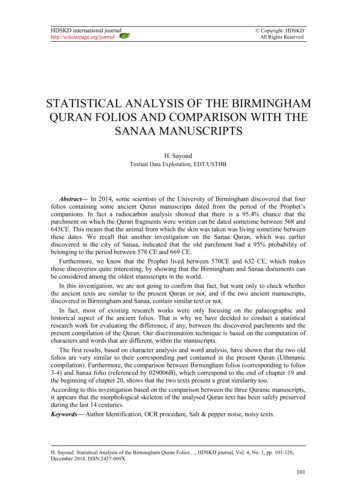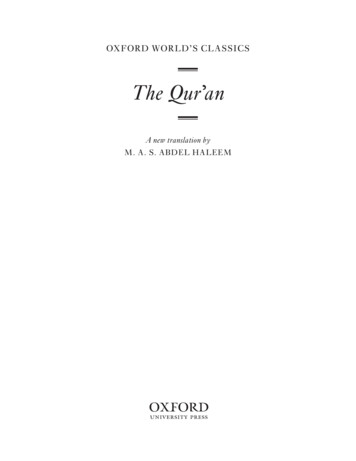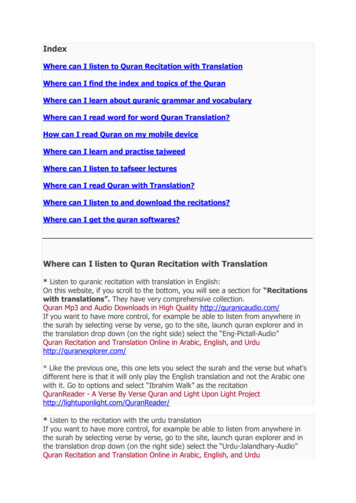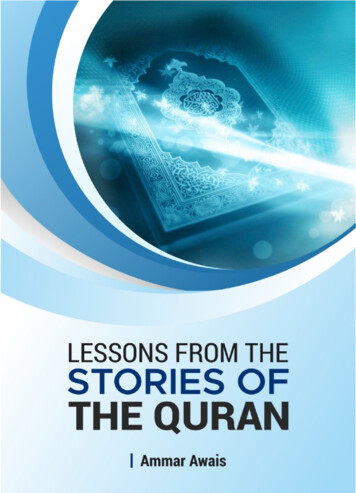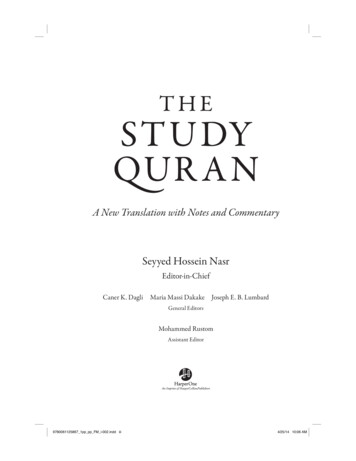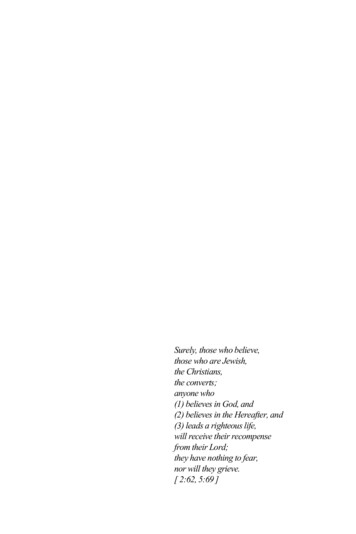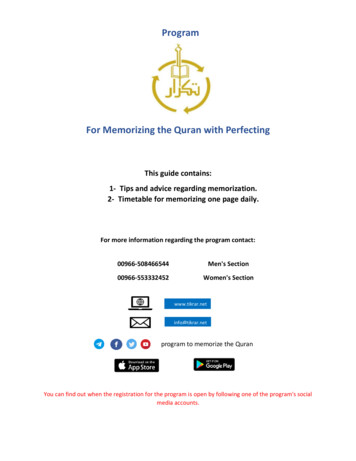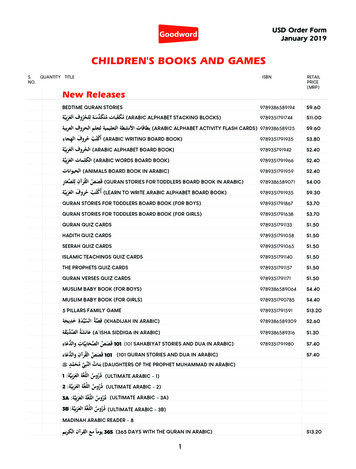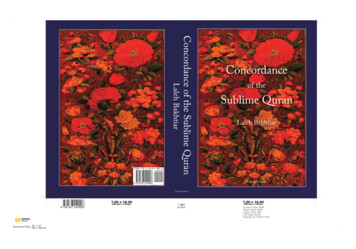
Transcription
ﻚ ا َﻻ ْآ َﺮ ُم َ ِا ْﻗﺮَأ َو َر ﱡﺑ ﻋﱠﻠ َﻢ ﺑِﺎ ْﻟ َﻘ َﻠ ِﻢ َ َاﱠﻟﺬِى ن ﻣَﺎﻟَﻢ َﻳ ْﻌ َﻠ ُﻢ َ ﻋﱠﻠ َﻢ ا ِﻻ ْﻧﺴَﺎ َRecite and your Fosterer is Most Honourable.Who taught with the pen.He taught man that which he did not know.ELEMENTARY GRAMMAR OF THE HOLYQURANIntroductionIt’s very tragic that most of us recite the Holy Quran, the word of ALLAH, the bookof instructions, the only Source of authentic knowledge, without understanding it.We offer Salat, reciting passages in Arabic which we do not mean, because again wedo not understand what we say.In our worldly life, for nominal financial and social benefits, we take painseven in old age, to learn any language imposed on us. We spend hundreds andthousands of rupees on private tuitions for our children, to make them understandhighly complicated subjects of Mathematics and Science, but when the problem ofunderstanding the Holy Quran is posed, we are indifferent. Are we not answerablefor this indifferent attitude of ours? Yes! It is in response to this fear that this workhas been prepared so as to help the English knowing readers of the Holy Quran inlearning basic important rules of grammer used in the Holy Quran.The Holy Quran contains 1800 and odd basic root words which have beenrepeated in a variety of grammatic forms. Some of these words convey more thanone meaning. All these words add up to 2000 and odd. If one learns the meanings ofthese 2000 and odd words and the grammatic rules to use them correctly in framingsentences, then, Insha Allah, in due course of time, he may be able to understand
nearly the whole of the Holy Quran without the help of any translation and he mayalso be able to offer his Salat knowing the meaning of every word he recites. Aren’tthese great temptations to understand, memorise and digest this small book?May Allah help us, in fulfilling this desire with the sole aim of practicallyimplementing all that we understand, and there by achieve success and happiness inthis world and in the hereafter. Ameen.Dr. MIR ANEESUDDIN, M.Sc., Ph.D. (Osm)CONTENTSELEMENTARY GRAMMER / PRONOUNS & WORDS OTHER THAN NOUNSAND VERBSARABIC WORDSNOUNٌ ِاﺱْﻢ Noun is the name of any person, place or thing. Following varieties of nouns deserveour attention. ﺱ ِﻢ ﺟَﺎ ِﻣ ْﺪ ْ ِا INFLEXIBLE NOUN VERBAL NOUN COMMON NOUN PROPER NOUN ACTIVE NOUN ( SUBJECT ) PASSIVE NOUN ( OBJECT ) NOUN OF PLACE AND TIME ﺼ ِﺪ ٌر ْ َﻣ ﺱ ِﻢ ِﻧﻜِﺮة ْ ِا ﺱ ِﻢ ﻣَ ْﻌﺮِﻓَﻪ ْ ِا ﻓَﺎﻋِ ْﻞ َﻣ ْﻔ ُﻌ ْﻮ ٌل اﺱﻢ ﺿﺮف و ﻣﻜﺎن و زﻣﺎن
ِاﺱْﻢ ﺁﻟﻪ NOUN OF THE INSTRUMENT ADJECTIVE NOUN OF EXAGERATION COMPARATIVE NOUN ﻀﻴْﻞ ِ ﺱ ِﻢ َﺗ ْﻔ ْ ِا NOUN OF MULTITUDE ﺟ َﻤ ْﻊ َﺗ ْﻜ ِﺜﻴْﺮ َ RELATIVE NOUNS GENDER ( MASCULINE, FEMININE ) NUMBER:- SINGULAR, DUAL, PLURAL ﺖ ْ ﺹ َﻔ ِ ﺱ ِﻢ ْ ِا ِاﺱْﻢ ُﻣﺒَﺎ ِﻟﻐَﻪ ﺿﻤَﺎﻧِﺮ َPRONOUNSVERB ﻓَﻌَﻞ Verb is a word that indicates an action associated with past, present or future. ﻓﻌﻞ ﻻ زم INTRANSITIVE VERB TRANSITIVE VERB PAST TENSE ACTIVE VOICE ﻓﻌﻞ ﻣﺎﺿﻲ ﻣﻌﺮوف PAST TENSE PASSIVE VOICE ﻓﻌﻞ ﻣﺎﺿﻲ ﻣﺠﻬﻮل AORIST TENSE AORIST TENSE, ACTIVE VOICE ﻓﻌﻞ ﻣﻀﺎرع ﻣﻌﺮوف AORIST TENSE PASSIVE VOICE ﻓﻌﻞ ﻣﻀﺎرع ﻣﺠﻬﻮل OTHER FORMS OF PAST TENSE OTHER FORMS OF AORIST TENSE IMPERATIVE MOOD ﻓﻌﻞ ﻣﺘﻌﺪي ﻓﻌﻞ ﻣﻀﺎرع اَﻣﺮ
PROHIBITIVE ﻧَﻬِﻲ IMPERATIVE AND PROHIBITIVE MOODS OF FIRST ANDTHIRD PERSONS DERIVATIVES OF TRILITERALS ﺙَﻼَﺙِﻲ َﻣ ِﺰ ْﻳ ِﺪ ِﻓ ْﻴ ِﻪ WORDS OTHER THAN NOUNS AND VERBS PREPOSITIONS CONJUNCTION WORDS USE FOR QUESTIONS AFFIRMATIVE WORDS NEGATIVE WORDS WORDS CONVEYING CONDITION DIRECTIONAL WORDS OTHER PARTICLESPHASES AND SENTENCESA group of two or more words is know as a ﺮآﱠﺐ َ ( ُﻣ compound ). PHRASE SENTENCECHAPTER – 1ARABIC WORDSIn Arabic language, most of the Nouns and Verbs are derived from words normallyconsisting of a minimum of 3 alphabets like
ﻋ َﺒ َﺪ َ - عبد He worshipped َﻓ َﻌ َﻞ - ف ع ل He didThe meaning, gender, number, tense etc. of any root word can be altered, byadding appropriate alphabets in the beginning, middle or at the end and also bychanging the signs above and below each alphabets. َا ْﻗ ُﺘ ُﻞ I murderMurderer ﻗَﺎ ِﺗ ٌﻞ We murdered َﻗ َﺘ ْﻠﻨَﺎ He murdered َﻗ َﺘ َﻞ He was murdered ُﻗ ِﺘ َﻞ Thus from a single 3 lettered root word numerous other words can bederived but the basic meaning of the root words is normally retained in some formor the other.There are 8 signs which are marked above or below an alphabet to producesounds shown below :u,as in whoa,as in fare,as in seenun , as in dhunan,as in runin ,as in pin.
orare used for abrupt stop, as in “cut”repeating the sound of an alphabet as in running, ﺖ ْ َﻓ َﻌ َﻠ for اﻟّﻠﻪ . Nouns can be identified by َا ْل as in ن ُ ﺣﻤَﺎ ْ اَﻟ ﱠﺮ or in the signs,oron the lastٌ َز ْﻳ , ﺹﺮًا ِ ﻧَﺎ or ﺣَﺎ ِﻣ ٍﺪ . A verb can be identified when it isalphabet of a world ﺪ the prefixprefixed by ﺪ ْ َﻗ , َل , ف َ ﺱ ْﻮ َor س َand by the signPast tenseHe has killedPresent tenseHe knowsFuture tenseHe will strikeFuture tenseYou will knowon the last alphabet. َﻗ ْﺪ َﻗ َﺘ َﻞ َﻳ ْﻌ َﻠ ُﻢ ب ُ ﻀ ِﺮ ْ ﺱ َﻴ َ ن َ ف َﺗ ْﻌ َﻠ ُﻤ ْﻮ َ ﺱ ْﻮ َ ُا ْﻗ ُﺘ ْﻞ Order( you ) killThe number of alphabets and their signs in the case of the preposition usedfor joining nouns and verbs are fixed :from ﻦ ْ ِﻣ over ﻋَﻠﻰ in ﻲ ْ ِﻓ The three lettered word ﻞ َ َﻓ َﻌ meaning ‘to work’, is usually selected todemonstrate the changes that can be brought about in the meaning, gender, tenseetc. of a root word by altering the signs of and increasing the number of alphabets :works ل ٌ َا ْﻓﻌَﺎ You ( will ) work ﻞ ُ َﺗ ْﻔ َﻌ one who works ﻞ ٌ ﻋ ِ ﻓَﺎ ٌ َﻓ ْﻌ work ﻞ When the root words contains the vowels ي or و or ا then along with the signssome of the letters too are changed or even dropped. In the case of the root word َﻗ ْﻮ ٌل instead of writing َﻗ ْﻮ َل for the third person singular past tense, it is writtenَ ﻗَﺎ that is و is replaced by ا . In the case of the root letter و ق ي for theas ل ِ meaning “Guard” as in ب اﻟﻨﱠﺎ ِر َ ﻋﺬَا َ ِﻗﻨَﺎ imparative form, only one letter is used ق ( guard or save us from the punishment of fire )CHAPTER – IINOUN ﺱ ٌﻢ ْ ِا
Noun is the name of any person, place or thing. Following varieties of nouns deserveour attention.1. INFLEXIBLE NOUN ﺱ ِﻢ ﺟَﺎ ِﻣ ْﺪ ْ ِا A noun which has not been derived from an infinitive :ٌ ِﻓ ْﻴ Elephant ﻞ Horse س ٌ َﻓ َﺮ 2. VERBAL NOUN ﺼ ِﺪ ٌر ْ َﻣ A noun that has been derived from an infinitive and from which other words arederived :( Infinitive )To murder ( Noun )Murder ( Derived subject )Murderer ( Derived object )one who is murdered َﻗ َﺘ َﻞ َﻗ ْﺘ ٌﻞ ﻗَﺎ ِﺗ ٌﻞ َﻣ ْﻘ ُﺘ ْﻮ ٌل 3. COMMON NOUN ﺱ ِﻢ ِﻧﻜِﺮة ْ ِا These nouns refer to Classes or groups of things :ٌ ﺠ ْ َﻧ Star ﻢ 4. PROPER NOUNHouse ﺖ ٌ َﺑ ْﻴ ﺱ ِﻢ َﻣ ْﻌ ِﺮﻓَﻪ ْ ِا These nouns refer to particular persons, places or things like : ﺣَﺎ ِﻣ ٌﺪ ، َﻣ ﱠﻜ ٌﺔ When the alphabets ل ْ َا are prefixed to a common noun, it gets converted to aproper noun, imparting the meaning of the English article “THE”The StarThe House ﺠ ُﻢ ْ اَﻟﻨﱠ ﺖ ُ َا ْﻟ َﺒ ْﻴ The noun in subjective case ( active ) ends innoun is objective case( passive ) ends inI struck Hamidpreceded by a preposition end inHamid became ﺖ ﺣَﺎ ِﻣﺪًا ُ ﺿ َﺮ َﺑ َI went towards Hamid ﺟَﺎ َء ﺣَﺎ ِﻣ ٌﺪ . The. The noun which is ﺖ إﻟﻰ ﺣَﺎ ِﻣ ٍﺪ ُ َذ َه َﺒ .
َا ْل then the last alphabet will be marked byIn case the noun is prefixed withrespectively instead of. ﻋ ْﻞ ِ ﻓَﺎ 5. ACTIVE NOUN – SUBJECTThis noun is derived from the root word by addingmarking the sign ا after the first alphabet andon the central alphabet. ﺹ ٌﺮ ِ ﻧَﺎ - ﺼ َﺮ َ َﻧ ﺢ ٌ ﻓَﺎ ِﺗ - ﺢ َ َﻓ َﺘ One who helpsOne who opens َﻣ ْﻔ ُﻌ ْﻮ ٌل 6. PASSIVE NOUN – OBJECTThis noun is derived from the root word by prefixing م َ and inserting و between the.second and third letters. The central alphabet is marked with the sign ﺼ ْﻮ ٌر ُ َﻣ ْﻨ - ﺼ َﺮ َ َﻧ ح ٌ َﻣ ْﻔ ُﺘ ْﻮ - ﺢ َ َﻓ َﺘ One who is helpedone that is opened اﺱﻢ ﺿﺮف و ﻣﻜﺎن و زﻣﺎن 7. NOUN OF PLACE AND TIMEThe noun has م with signprefixed to the root word. The central alphabet hasthe sign ع ْ ِﻓ ْﻌ ِﻞ ُﻣﻀَﺎ ِر if the Aorist verbhasoralphabet of the root word. The central alphabet will havecentral alphabet of the Aorist verb also hasName of Place / TimeOpeningHelpingSittingmarked on it, if themarked on it.Aorist Verb ح ٌ َﻣ ْﻔ ُﺘ ْﻮ ﺼ ٌﺮ َ َﻣ ْﻨ ﺲ ٌ ﺠ ِﻠ ْ َﻣ ﺢ ُ َﻳ ْﻔ َﺘ ﺼ ُﺮ ُ َﻳ ْﻨ ﺲ ُ ﺠ ِﻠ ْ َﻳ ( Exceptions to the rule ) ق ُ ﺸ ِﺮ ْ َﻣ ﺠ ُﺪ ِ ﺴ ْ َﻣ on the central ق ُ ﺸ َﺮ ْ َﻳ ﺠ ُﺪ ُ ﺴ ْ َﻳ
ﺼﻠّﻰ َ ُﻣ ُﻳﺼَﻠﱢﻲ 8. NOUN OF THE INSTRUMENT ِاﺱْﻢ ﺁﻟﻪ Names of working instruments. There are three formsPloughKeyFan( )ح رث ( )فتح ( )روح ث ٌ ﺤ َﺮ ْ ِﻣ ح ٌ ﻣَ ْﻔﺘَﺎ ﺣ ٌﺔ َ ِﻣ ْﺮ َو ِﻣ ْﻔ َﻌ ٌﻞ ﻣِ ْﻔﻌَﺎ ٌل ِﻣ ْﻔ َﻌ َﻠ ٌﺔ ﺖ ْ ﺹ َﻔ ِ ﺱ ِﻢ ْ ِا 9. ADJECTIVEThese words indicate qualities or attributes of nouns. In some cases, after the secondalphabet of the root word, one of the vowels ي , و or ا is added as follows :GoodDignifiedBrave ﻒ ٌ ﺵ ِﺮ ْﻳ َ وَ ُﻗ ْﻮ ٌر ع ٌ ﺵﺠَﺎ ُ( )شرف ( )وقر ( )شجع Following forms are also usedDifficultBeautifulHardVery happyBeneficent ﺐ ٌ ﺹَ ْﻌ ﻦ ٌ ﺴ َ ﺣ َ ﺐ ٌ ﺹ ْﻠ ُ ح ٌ َﻓ ِﺮ ن ٌ ﺣﻤَﺎ ْ َ ر ﻓَ ْﻌ ٌﻞ َﻓ َﻌ ٌﻞ ُﻓ ْﻌ ٌﻞ َﻓ ِﻌ ٌﻞ ن ٌ ﻓَﻌْﻼ 10. NOUNS OF EXAGGERATION ِاﺱْﻢ ُﻣﺒَﺎ ِﻟﻐَﻪ To express an excess of some quality, following terms of the root word ﻓﻌﻞ are used.Very cautiousVery mercifulHeavy eaterVery learnedVery elderlyVery truthfulCutterGreat bestowerVery poor ﺣ ِﺬ ٌر َ ﺣ ْﻴ ٌﻢ ِ َر اَ ُآ ْﻮ ٌل ﻼ ٌم ّ َ ﻋ ُآﺒﱠﺎ ٌر ﻖ ٌ ﺹ ﱢﺪ ْﻳ ِ ﺠ َﺰ ٌم ْ ِﻣ ﻣِ ْﻨﻌَﺎ ٌم ﻦ ٌ ﺴ ِﻜ ْﻴ ْ ِﻣ َﻓ ِﻌ ٌﻞ َﻓ ِﻌ ْﻴ ٌﻞ ﻓَ ُﻌ ْﻮ ٌل ﻓَﻌﱠﺎ ٌل ُﻓﻌﱠﺎ ٌل ﻓِ ﱢﻌ ْﻴ ٌﻞ ِﻣ ْﻔ َﻌ ٌﻞ ﻣِ ْﻔﻌَﺎ ٌل ِﻣ ْﻔ ِﻌ ْﻴ ٌﻞ
ب ٌ ﻋﺠَﺎ ُ ق ٌ ﻓَﺎ ُر ْو ﺤ َﻜ ٌﺔ ْ ﺿ ُ َﻗ ﱡﻴ ْﻮ ٌم س ٌ ُﻗ ﱡﺪ ْو ﺐ ٌ ُﻗﱠﻠ Very peculiarGreat differentiatorOne who laughsEstablished oneVery holyOne who finds excuses ُﻓﻌَﺎ ٌل ﻋ ْﻮ ٌل ُ ﻓَﺎ ُﻓ ْﻌ َﻠ ٌﺔ َﻓ ﱡﻌ ْﻮ ٌل ُﻓ ﱡﻌ ْﻮ ٌل ُﻓ ﱠﻌ ٌﻞ ﻀﻴْﻞ ِ ﺱ ِﻢ َﺗ ْﻔ ْ ِا 11. COMPARATIVE NOUNThese nouns are used for comparison. Derived from the root word ﻓﻌﻞ the word ﻓﻌﻴﻞ means one who has the capacity to work. The forms ( اﻓﻌﻞ masculine ) and ( ﻓﻌﻠﻰ feminine ) show comparative capacity of doing more work, followingexamples throw more light.ComparativefeminineComparativemasculine ﺹﻐْﺮى ُ ُآﺒْﺮى Noun ﺹ َﻐ ُﺮ ْ َا َا ْآ َﺒ ُﺮ Comparative nouns do not have the prefixthe last alphabet. ﺹ ِﻐ ْﻴ ٌﺮ َ َآ ِﺒ ْﻴ ٌﺮ ال or the signsoron ﺟ َﻤ ْﻊ َﺗ ْﻜ ِﺜﻴْﺮ َ12. NOUN OF MULTITUDEٌ to certain singular nounsThe noun is derived by suffixing ة ﺠ َﺮ ٌة َ ﺵ َMany trees ﺠ ٌﺮ َ ﺵ َ13. RELATIVE NOUNSWhen ي ٌ is suffixed to certain nouns, the derived word conveys the sense ofbelonging to : ﻲ ﻋ َﺒ ِﺒ ﱞ َ ي ِه ْﻨ ِﺪ ﱞ Belonging to ArabiaBelonging to India ب ٌ ﻋ َﺮ َ ِه ْﻨ ٌﺪ 14. GENDER – MASCULINE , FEMININEIn most cases a feminine noun can be identified by the suffix ة ٌMasculineFeminine ﻋَﺎ ِﺑ ٌﺪ ﻋَﺎ ِﺑ َﺪ ٌة ﺟ ٌﺪ ِ ﺱَﺎ ﺟ َﺪ ٌة ِ ﺱَﺎ ﻋَﺎ ِﻟ ٌﻢ ﻋَﺎ ِﻟ َﻤ ٌﺔ
When the masculine noun is the equivalent of the word َا ْﻓ َﻌ ْﻞ its feminine is either ُﻓﻌْﻠﻰ or ُﻓﻌْﻼ ُء MasculineFeminine َا ْﻓ َﻌ ُﻞ ﺹ َﻐ ُﺮ ْ َا ﺹ َﻔ ُﺮ ْ َا ُﻓﻌْﻼ ُء - ُﻓﻌْﻠﻰ ﺹﻐْﺮى ُ ﺹ ْﻔﺮَا ُء َThere are some irregular forms which do not end in ة ٌ or اى or اء yet they areconsidered feminine :Fire ر ٌ ﻧَﺎ Earth ض ٌ َا ْر Sky ء ٌ ﺱﻤَﺎ َ15. NUMBER :- SINGULAR, DUAL, PLURALDual ( for two things ): To convert singular to dual, اِن is added at the end of theٌ ﻋ ِ ﻓَﺎ and ﻦ ِ َﻳ at the end of passive noun, that is, objectactive noun, that is, subject ﻞ َﻣ ْﻔ ُﻌﻮْل . The alphabet just before ن ِ َا or ﻦ ِ ْﻳ is marked with the signlast ن of the dual always has the signSingularDual Passive.Dual Active ﻦ ٌ ﻋ ْﻴ َ ن ِ ﻋ ْﻴﻨَﺎ َ ﻦ ِ ﻋ ْﻴ َﻨ ْﻴ َ َﻳ ٌﺪ ن ِ َﻳﺪَا ﻦ ِ َﻳ َﺪ ْﻳ ﻋَﺎ ِﻟ َﻤ ٌﺔ ن ِ ﻋَﺎ ِﻟ َﻤﺘَﺎ ﻦ ِ ﻋَﺎ ِﻟ َﻤ َﺘ ْﻴ Two eyesTwo handsTwo learned womenand thePlural has two kinds : ﺟﻤَﻊ ﺱَﺎ ِﻟ ْﻢ َ( 2 ) Broken plural – ﺮ ْ ﺴ ﺟﻤَﻊ ُﻣ َﻜ ﱠ َ( 1 ) Sound plural -In sound pluralorder. ون ﺟﻤَﻊ ﺱَﺎ ِﻟ ْﻢ َalphabets of the singular form remain in the sameis added at the end of active noun subjectpassive noun object َﻣ ْﻔ ُﻌﻮْل . The letter before و ﻓَﺎﻋِﻞ and ﻦ َ ْﻳ at the end ofis marked withfor the
active noun and the letter before ي The last ن is marked with. Feminine sound plural is made by adding ت ٌ ا tois marked withfor the passive noun.ٍ ا to passive masculine noun.active masculine noun and ت SingularPlural Passive ﻋَﺎ ِﻟ ٌﻢ ن َ ﻋَﺎ ِﻟ ُﻤ ْﻮ ﻦ َ ﻋَﺎ ِﻟ ِﻤ ْﻴ ﻋَﺎ ِﻟ َﻤ ٌﺔ ت ٌ ﻋَﺎ ِﻟﻤَﺎ ت ِ ﻋَﺎ ِﻟﻤَﺎ Masc.Fem.Plural ActiveSUMMARY OF NUMBER, SING., DUAL ANDSOUND PLURALMASCULINEFEMININEActiveSing.DualPlu.Passive ﻓﺎﻋﻞ ﻣﻔﻌﻮل ﺴ ِﻠ ٌﻢ ْ ُﻣ ﺴ ِﻠﻤًﺎ ْ ُﻣ ن ِ ﺴ ِﻠﻤَﺎ ْ ﻦ ُﻣ ِ ﺴ ِﻠ َﻤ ْﻴ ْ ُﻣ ن َ ﺴ ِﻠ ُﻤ ْﻮ ْ ﻦ ُﻣ َ ﺴ ِﻠ ِﻤ ْﻴ ْ ُﻣ PrepositionActive ﺣﺮف ﺴ ِﻠ ٍﻢ ْ ُﻣ PassivePreposition ﻓﺎﻋﻞ ﻣﻔﻌﻮل ﺴ ِﻠ َﻤ ٌﺔ ْ ُﻣ ﺴ ِﻠ َﻤ ًﺔ ْ ُﻣ ن ِ ﺴ ِﻠ َﻤﺘَﺎ ْ ﻦ ُﻣ ِ ﺴ ِﻠ َﻤ َﺘ ْﻴ ْ ُﻣ ت ٍ ﺴ ِﻠﻤَﺎ ْ ت ُﻣ ِ ﺴ ِﻠﻤَﺎ ْ ُﻣ ﺣﺮف ﺴ ِﻠ َﻤ ٍﺔ ْ ُﻣ In broken plural, the original form of the singular is changed by addition orremoval of alphabets and changing the signs associated with the original alphabets.SingularPluralSingularPlural ب ٌ ِآﺘَﺎ َﻗ َﻠ ٌﻢ َاﻗْﻼ ٌم ﺟ ٌﻞ ُ َا ْر ﺖ ٌ َﺑ ْﻴ ت ٌ ُﺑ ُﻴ ْﻮ ﺠ ٌﺪ ِ ﺴ ْ َﻣ ﺟ ٌﺪ ِ َﻣﺴَﺎ ﺐ ٌ ُآ ُﺘ ﺟ ٌﻞ ُ َر ب ٌ ِﺙﻴَﺎ ب ٌ َﺙ ْﻮ CHAPTER – III
ﺿﻤَﺎﺋِﺮ َPRONOUNSA pronoun is a word used in place or instead of a noun.َ ( ِاﻳﱠﺎ only you ),If ِاﻳﱠﺎ is prefixed to passive pronouns, it imparts the sense of only, ك ( ِاﻳﱠﺎﻧَﺎ only we ).NEARSThis هﺬَا 3. Demonstrative PronounsMasculineFeminineDPSDPThose AllThisThese AllTwotheseTwothose ن ِ هﺬا ﻦ ِ ه َﺬ ْﻳ ه ُﻮ َﻻ ِء ه ِﺬ ِﻩ ن ِ هَﺎﺗَﺎ ﻦ ِ هَﺎ َﺗ ْﻴ اﺳﻢ اﺷﺎرﻩ MasculineDPSThose AllThatTwoThoseSThat َه ْﻮ َﻻ ِء ﻚ َ ذ ِﻟ ﻚ َ ذَا ِﻧ ﻚ َ َذ ْﻳ ِﻨ 4. Relative Pronouns ﻦ ْ َﻣ WhoWhoWhoWhoWhoWhich Which Which Which Whichwhich twoalltwoall ن ِ َاﱠﻟﺬَا ﻦ َ َاﱠﻟ ِﺬ ْﻳ اَﻟﱠﺘِﻲ ﻦ َ َاﱠﻟ ِﺬ ْﻳ GenderMFSIwe too َاﻧَﺎ " ﻦ ُ ﺤ ْ َﻧ "MineMFMy fosterer ي " رَﺑﱢﻲ ن ِ َاﱠﻟﺘَﺎ P ﻦ ُ ﺤ ْ َﻧ "Our Fosterer ﻧَﺎ " رَ ﱠﺑﻨَﺎ ﻚ َ اُوﻻ ِﻧ what َا ﱠﻻﻧِﻲ whichforinanimatesforlivingbeingsSSecond PersonDP1. Personal Pronouns ﻲ ْ ﺼ ِ ﺨ ْ ﺷ َ ﺿ ِﻤ ْﻴ ِﺮ َyouyou two ﺖ َ َا ْﻧ ﺖ ِ َا ْﻧ َا ْﻧ ُﺘﻤَﺎ " ﻲ ْ ﺿ ِﻤ ْﻴ ِﺮ ِاﺿَﺎ ِﻓ َ2. Possessive Pronouns to be suffixedOurs twoOursYoursYours two ﻧَﺎ " ﺗَﺎﻧِﻚ ﻚ َ َﺗ ْﻴ ِﻨ ﻣَﺎ َا ﱠﻻﺗِﻲ who ﻦ ِ َاﱠﻟ َﺘ ْﻴ First PersonD ﻚ َ ِﺗ ْﻠ 5. Introgative PronounsWho ي ْ َاﱠﻟ ِﺬ ﻚ َ اُوﻻ ِﻧ FARFeminineDPThose AllTwoThose ك َ ك ِ ُآﻤَﺎ "Your heart CHAPTER – IVVERB ﻓﻌﻞ SThird PersonDPyou allHe/SheThey twoTheyall َا ْﻧ ُﺘ ْﻢ َا ْﻧ ُﺘﻦﱠ ُه َﻮ ﻲ َ ِه ُهﻤَﺎ " ُه ْﻢ ﻦ ْ ُه Yours allHis\Her ُآ ْﻢ ُآﻦﱠ ﻚ َ َﻗ ْﻠ ِﺒ ُﻩ هَﺎ We provided them Their two Theirs ُهﻤَﺎ " َر َز ْﻗﻨَﺎ ُه ْﻢ ُه ْﻢ ُهﻦﱠ
Verb is a word that indicates an action associated with past, present or future. ﻓﻌﻞ ﻻ زم 1. INTRANSITIVE VERBIt denotes an action by the subject which does not pass over to an object. ﺟَﺎ َء ﺣَﺎ ِﻣ ٌﺪ Hamid came ﻓﻌﻞ ﻣﺘﻌﺪي 2. TRANSITIVE VERBThis verb denotes an action which passes over from the doer or subject to anobject. ﺖ ﺣَﺎ ِﻣﺪًا ُ ﺿ َﺮ ْﺑ َI struck Hamid ﻓﻌﻞ ﻣﺎﺿﻲ ﻣﻌﺮوف 3.a PAST TENSE ACTIVE VOICEIn this form of the verb, the first and the last alphabets of a three letteredroot word have the signalphabet may change. َآ ُﺮ َم marked on them, while the sing on the central ﺱ ِﻤ َﻊ َ ﺢ َ َﻓ َﺘ Different forms of first, second and third persons, masculine and feminine gendersand singular, dual and plural numbers used in the active voice of past tense are asfollows : S Singular, D Dual and P Plural.SHe killed.DThey two killed.ThirdPThey all killed.PersonSShe killed.DThey two killed.PThey all killed.SYou killed.DYou two killed.PYou all killed.SYou killed.DYou two killed.PYou all eFemininePersonFirstMasculine orSI killed.PersonFeminineD/PWe killed. َﻗ َﺘ َﻞ ﻼ َ َﻗ َﺘ َﻗ َﺘُﻠﻮْا ﺖ ْ َﻗ َﺘ َﻠ َﻗ َﺘ َﻠﺘَﺎ ﻦ َ َﻗ َﺘ ْﻠ ﺖ َ َﻗ َﺘ ْﻠ َﻗ َﺘ ْﻠ ُﺘﻤَﺎ َﻗ َﺘ ْﻠ ُﺘ ْﻢ ﺖ ِ َﻗ َﺘ ْﻠ َﻗ َﺘ ْﻠ ُﺘﻤَﺎ ﻦ َﻗ َﺘ ْﻠ ُﺘ ﱠ ﺖ ُ َﻗ َﺘ ْﻠ َﻗ َﺘ ْﻠﻨَﺎ
ﻣَﺎ ﻣَﺎ َﻗ َﺘ َﻞ ﻣَﺎ َﻗ َﺘ ْﻠﻨَﺎ ﺖ ْ ﻣَﺎ َﻗ َﺘ َﻠ ﻣَﺎ َﻗ َﺘ ْﻠ ُﺘﻤَﺎ To make negative prefixHe did not killWe did not killShe did not killYou two did not kill ﻓﻌﻞ ﻣﺎﺿﻲ ﻣﺠﻬﻮل 3.b PAST TENSE, PASSIVE VOICETo obtain this form of the verb, the sign of the first alphabet of all the activeverbs is changed toPassiveand that of the second to.Active ﺐ َ ُذ ِه ﺐ َ َذ َه He was made to goHe went ُﻗ ِﺘ ْﻠﻨَﺎ َﻗ َﺘ ْﻠﻨَﺎ We were killedWe killed ﻣَﺎ ﻣَﺎ ُﻗ ِﺘ ْﻠ ُﺘ ْﻢ ﺐ َ ﻣَﺎ ُذ ِه To make negative prefixYou were not killedHe was not made to go ﻓﻌﻞ ﻣﻀﺎرع 4. AORIST TENSEIn Arabic language, present and future tense are represented by a singletense known as Aorist tense. These are some prefixes which sometime help indistinguishing present from future tense but mostly this verb represents both thetenses.4.a AORIST TENSE, ACTIVE VOICE ﻓﻌﻞ ﻣﻀﺎرع ﻣﻌﺮوف This form of the verb has as a prefix to the root word, one of the alphabets تني marked with the signmarked with the sign. The first alphabet of the root word isand the last with the signmay have one of the three signs ا ,or, the central alphabet.
Different forms of the 1st, 2nd and 3rd persons masculine and femininegenders, and singular, dual and plural numbers used in the active voice of Aoristtense are as follows :SHe Kills / will kill.DThey two kill / will kill.ThirdPThey all kill / will kill.PersonSShe kills / will killDThey two kill / will kill.PThey all kill / will kill.SYou Kill / will kill.DYou two kill / will kill.PYou all kill / will kill.SYou kill / will kill.DYou two kill / will kill.PYou all kill / will eFirstMasculine orSI kill / will kill.PersonFeminineD/PWe kill / will kill. َﻳ ْﻘ ُﺘ ُﻞ ن ِ ﻼ َ َﻳ ْﻘ ُﺘ ن َ َﻳ ْﻘ ُﺘُﻠ ْﻮ َﺛ ْﻘ ُﺘ ُﻞ ن ِ ﻼ َ ُﺛ ْﻘ ُﺘ ﻦ َ َﻳ ْﻘ ُﺘ ْﻠ َﺗ ْﻘ ُﺘ ُﻞ ن ِ ﻼ َ َﺗ ْﻘ ُﺘ ن َ َﺗ ْﻘ ُﺘُﻠ ْﻮ ﻦ َ َﺗ ْﻘ ُﺘ ِﻠ ْﻴ ن ِ ﻼ َ َﺗ ْﻘ ُﺘ ﻦ َ َﺗ ْﻘ ُﺘ ْﻠ َا ْﻗ ُﺘ ُﻞ َﻧ ْﻘ ُﺘ ُﻞ To make negative Aorist tense active voice ﻻ َ is prefixed : َﻻ َﻳ ْﻘ ُﺘ ُﻞ َﻻ َﻧ ْﻘ ُﺘ ُﻞ He does not / will not killWe do not / will not kill4.b AORIST TENSE, PASSIVE VOICE ﻓﻌﻞ ﻣﻀﺎرع ﻣﺠﻬﻮل To convert Aorist active to passive voice the signalphabets ي ا ت ن is changed tosign.and the third alphabet is marked with theActivePassiveHe is killed / will be killedon the prefixed ُﻳ ْﻘ َﺘ ُﻞ He kills / will kill َﻳ ْﻘ ُﺘ ُﻞ
5. OTHER FORMS OF PAST TENSEa) Immediate past / present perfect : Whenpresent perfect tense. ﻗﺪ is prefixed to past tense, we obtain ج َ ﺧ َﺮ َ َﻗ ْﺪ He has come outb) Past perfect : To obtain the formsingular.َ آَﺎن is prefixed to the past tense, third person ﺐ َ آَﺎنَ َآ َﺘ For different genders, numbers and persons, derivatives of َ آَﺎن He had writtenare used followingthe rules for past tense active voice detailed earlier. All the forms in that sequenceare as follows :FEMININEPDSPDS ُآﻦﱠ ُآ ْﻨ ُﺘﻦﱠ آَﺎ َﻧﺘَﺎ ُآ ْﻨ ُﺘﻤَﺎ ﺖ ْ آَﺎ َﻧ ﺖ ِ ُآ ْﻨ آَﺎ ُﻧﻮُا ُآ ْﻨ ُﺘ ْﻢ MandFSDand P آَﺎﻧَﺎ ُآ ْﻨ ُﺘﻤَﺎ ُآﻨﱠﺎ َ آَﺎ ن ﺖ َ ُآ ْﻨ ﺖ ُ ُآ ْﻨ PersonThirdSecondMASCULINEFirstc) Probability in Past : Prefixingprobability : ﻟَﻌَﻠﱠﻨَﺎ to the past tense imparts the sense ofProbably he has heard ﺱ ِﻤ َﻊ َ ﻟَﻌَﻠﱠﻨَﺎ d) Wishing in Past : Wishing to have done an action in the past, the wordprefixed to past tense :Wish I had guarded َﻟ ْﻴ َﺘﻤَﺎ is ﺖ ُ ﻈ ْ ﺣ ِﻔ َ َﻟ ْﻴ َﺘﻤَﺎ e) Used to do : Prefixing the word َ آَﺎن and its derivatives detailed above ( 5 b ), tothe appropriate Aorist tense gives the sense of having used to do something.He used to worshipI used to open آَﺎنَ َﻳ ْﻌ ُﺒ ُﺪ ﺢ ُ ﺖ َا ْﻓ َﺘ ُ ُآ ْﻨ f) Negative Past : ﻢ ْ َﻟ prefixed to aorist tense, converts it to negative past.He did not doWe did not kill َﻟ ْﻢ َﺗ ْﻔ َﻌ ُﻞ َﻟ ْﻢ َﻧ ْﻘ ُﺘ ُﻞ 6. OTHER FORMS OF AORIST TENSEa) Present tense :tense. َل prefixed to aorist tense active voice gives the sense of presentHe kills َﻟ َﻴ ْﻘ ُﺘ ُﻞ
b) Future tense : When the letter س َ is prefixed to an aorist tense, it gives the senseof near future and when the wordfuture : ف ٌ ﺱ ْﻮ َ is prefixed, it conveys the sense of distant ﺼ ُﺮ ُه ْﻢ ُ ﺱ َﻴ ْﻨ َُ ف َﻳ ْﺬ َه َ ﺱ ْﻮ َHe will go ( after some time ) ﺐ َ and suffixed with ن ﱠ andc) Future certainity : When aorist tense is prefixed with ل He will help them ( in near future )theon the last letter of the root word is changed tothe sense of definitely doing something in future.He will definitely dothe verb conveys ﻦ َﻟ َﻴ ْﻔ َﻌ َﻠ ﱠ ْ َﻟ prefixed to an aorist tense, it conveys the sense ofd) Future Negative : When is ﻦ never doing something in future.He will never do ﻦ َﻳ ْﻔ َﻌ ُﻞ ْ َﻟ ِل Prefixed to an aorist tense conveys the tense of should do :ِ ِﻟ َﻴ ْﻔ َﻌ He should do ﻞ َ Prefixed to an aorist tense verb gives the tense of should not do :f) Should not do : ﻻ ُ َﻻ َﻳ ْﻔ َﻌ He should not do ﻞ g) Will be : When اذا is prefixed to past tense, it conveys the sense of will be done ine) Should do :future : ﺖ ْ ﺤ َ اذا ُﻓ ِﺘ ْ ل َﻟ ﱠﻢ َﻟ ْﻢ ِا and ﻻ are prefixed to the aoristh) Changes due to prefixes : When ن tense, the last alphabet of those verbs which do not end in ن are to be marked byWhen it will be opened َﻳ ْﻌ َﻠ ُﻢ َﻟ ْﻢ َﺗ ْﻌ َﻠ ْﻢ . For verbs which end in ن ِ this ن is dropped (ْ ن َﻟﻤﱠﺎ َﻳ ِ َﻳ ْﻌ َﻠﻤَﺎ . When ن ْ ﻦ َا ْ ﻲ َﻟ ْ ﻲ َآ ْ ِﻟ َﻜ are prefixed toexcept in feminine plural ) ﻌ َﻠﻤَﺎ the signaorist tense not ending ن in the last alphabet is marked with ن ْ َﻳ ْﻌ َﻠ ُﻢ َا ﱠﻳ ْﻌ َﻠ َﻢ . For verbs ending in ن this ن is dropped َﻳ ْﻌَﻠﻤَﺎ ِن َﻳ ْﻌَﻠﻤَﺎ .7 a) Imperative mood اَﻣﺮ Imperative mood ( ordering or asking someone to do something ) is obtainedfrom aorist tense second person. First aorist tense alphabet ت in the beginning isremoved, then if the central alphabet is marked byorthe alphabet ا
with the signis prefixed. If the central alphabet is marked with then prefixedalphabet is also marked with. In both cases the last alphabet is marked withthe sign.ImperativeAoristImperativeAorist ب ْ ﺿ ِﺮ ْ ِا ب ُ ﻀ ِﺮ ْ َﺗ ﺢ ْ ِا ْﻓ َﺘ ﺢ ُ َﺗ ْﻔ َﺘ Imperative mood of different numbers and gendersFeminineMasculineAorist ﺐ ُ َﺗ ْﺬ َه ﻦ َ ِا ْذ َه ْﺒ ِا ْذ َهﺒَﺎ ﻲ ْ ِا ْذ َه ِﺒ ِا ْذ َه ُﺒﻮْا ِا ْذ َهﺒَﺎ ﺐ ْ ِا ْذ َه For root alphabets that start with ا this ا is dropped along with the alphabet of aoristtense ت and then the last alphabet is marked with the sign.ImperativeAoristImperative ُﻣ ْﺮ ﺗَﺎ ُﻣ ُﺮ ُآ ْﻞ َﺗ ْﺎ ُآ ُﻞ ( you ) order( you ) eatAorist7 b) Prohibitive َﻧﻬِﻲ To obtain this form ( ordering or asking someone not to do something ) َﻻ isprefixed to the aorist tense second person and the last alphabet is marked with thesign.Feminine ﻦ َ َﻻ َﺗ ْﺬ َه ْﺒ َﻻ َﺗ ْﺬ َهﺒَﺎ ﻲ ْ َﻻ َﺗ ْﺬ َه ِﺒ Masculine َﻻ َﺗ ْﺬ َه ُﺒﻮْا َﻻ َﺗ ْﺬ َهﺒَﺎ ﺐ ْ َﻻ َﺗ ْﺬ َه 7 c) Imperative and Prohibitive moods of first and third persons.These verbs are formed by prefixing ِل to the aorist verbs of first and thirdpersons, the last alphabet being marked by the signI should do ِﻟ َﺎ ْﻓ َﻌ ْﻞ He should worship ِﻟ َﻴ ْﻌ ُﺒ ْﺪ .When ف or و are present as prefix then this ل is marked withThen he should worship َﻓ ْﻠ َﻴ ْﻌ ُﺒ ْﺪ And I should bow ﺠ ْﺪ ُ ﺱ ْ َو ْﻟ َﺎ .
Prohibitive mood is obtained by prefixing the aorist first and third person verbswith َﻻ and marking the last alphabet with.He should not play ﺐ ْ َﻻ َﻳ ْﻠ َﻌ We should not write ﺐ ْ َﻻ َﻧ ْﻜ ُﺘ These rules are followed for feminine gender and other numbers too.8. DERIVATIVES OF TRILITERALS ﻼﺙِﻲ َﻣ ِﺰ ْﻳ ِﺪ ِﻓ ْﻴ ِﻪ َ َﺙ The word representing the third person singular in the past tense ( TPS P )normally contains three letters :He honoured ﺱ ِﻤ َﻊ َ َآ ُﺮ َم He opened ﺢ َ َﻓ َﺘ He heard ﺠ ﱠﺮ ْد َ ﻼﺙِﺜﻲ ُﻣ َ َﺙ These words are known as triliteralsAddition of more alphabets to these trilateral verbs introduces a wide scope foradditional meanings. Some important forms of these derived triliterals are listedbelow with examples of TP.S.P. of trilateral and their derivatives.DerivedTriliteralInfinitiveForm or ChapterTP.S.P.TP.S.P. ﻋﱠﻠ َﻢ َ ﻦ َ ﺴ َ ﺣ ْ َا ﺟَﺎ َه َﺪ َﺗﻜَﺎ َﺙ َﺮ ﻄ َﻊ َﺗ َﻘ ﱠ ﺐ َ ِا ْﻧ َﻘ َﻠ ﺐ َ ﺴ َ ِا ْآ َﺘ ﺱ َﺘ ْﻐ َﻔ َﺮ ْ ِا ﻋ ِﻠ َﻢ َ ﻦ َ ﺴ ُ ﺣ َ ﺟ َﻬ َﺪ َ َآ َﺜ َﺮ ﻄ َﻊ َ َﻗ ﺐ َ َﻗ َﻠ ﺐ َ ﺴ َ َآ ﻏ َﻔ َﺮ َ َﺗ ْﻌ ِﻠ ْﻴ ٌﻢ ن ٌ ﺣﺴَﺎ ْ ِا ُﻣﺠَﺎ َه َﺪ ٌة َﺗﻜَﺎ ُﺙ ٌﺮ ﻄ ٌﻊ َﺗ َﻘ ﱠ ب ٌ ﻼ َ ِا ْﻧ ِﻘ ب ٌ ِا ْآ ِﺘﺴَﺎ ﺱ ِﺘ ْﻐﻔَﺎ ٌر ْ ِا َﺗ ْﻔ ِﻌ ْﻴ ٌﻞ ِا ْﻓﻌَﺎ ٌل ﻋ َﻠ ٌﺔ َ ُﻣﻔَﺎ ﻋ ٌﻞ ُ َﺗﻔَﺎ َﺗ َﻔ ﱡﻌ ٌﻞ ِا ْﻧ ِﻔﻌَﺎ ٌل ِا ْﻓ ِﺘﻌَﺎ ٌل ﺱ ِﺘ ْﻔﻌَﺎ ٌل ْ ِا Some of the important changes these derivatives introduce are as follows :1. Intransitive verb changes to transitiveHe learned ( intransitive )He taught ( transitive )2. In place of one, two objects are required ﻋ ِﻠ َﻢ َ ﻋﱠﻠ َﻢ َZaid made Hamid read the book َآﺘَﺎﺑًﺎ 3. Sense of intensity, excess of exaggeration is conveyed :He killed intensely or excessively ﻗَﺎ َﺗ َﻞ 4. Repetition or step by step execution is indicated. َا ْﻗ َﺮَأ َز ْﻳ ٌﺪ ﺣَﺎ ِﻣﺪًا
He sent down repeatedly, step by step5. Absorption of a condition or action is shown : َﺗ َﻨ ﱠﺰ َل He got cut to pieces ﻄ َﻊ َﺗ َﻘ ﱠ 6. Absorption of a condition or action is shown :He got cut to pieces ﺢ َ ﺹ َﺒ ْ َا 7. Similar action by two persons/groups is shown. َﺗﻘَﺎ َﺑ َﻞ Came before one another8. Competition is exhibited, ﻖ َ ﺱَﺎ َﺑ One tried to overtake another9. Leaving off some work is shown :He gave up sleep ﺠ َﺪ َﺗ َﻬ ﱠ The derived triliterals are treated as root words and various other forms of verbsand infinitives are derived from them.Derivatives of ﻋﱠﻠ َﻢ َ are ﻋﱢﻠ َﻢ َ َﺗ ْﻌ ِﻠ ْﻴ ٌﻢ ُﻳ َﻌﻠﱠ ُﻢ ُﻣﻌَﱠﻠ ٌﻢ ُﻳ َﻌﻠﱢ ُﻢ ُﻣﻌَﱢﻠ ٌﻢ ﻋﱢﻠ َﻢ ُ َﻻ ُﺗ َﻌﱢﻠ ْﻢ Four and five lettered verbs which are not very common have not been discussedhere.CHAPTER VWORDS OTHER THAN NOUNS AND VERBS1. PREPOSITIONS( Nos. given after words are chapter and verse nos. of the Quran ) ﻦ ْ ِﻣ from ( 16:67 ) : of ( 6:144 ); because of ( 28:73 ); among ( 3:75 ); during ( 50:40 );any ( 3:62 ); according to( 65:6 ); instead of ( 9:38 ); than ( 97:3 ) ِل to, for ( 2:284; 106:1 ); that ( he might become ) ( 28:8 ) let ( 65:7 ); on ( 17:107 );about ( 10:77 ) َﻣ َﻊ with : together ب ِ with ( 2:63 ); during ( 17:79 ); in ( 15:46 ت َ used for oath ( 21:57 )); for ( 5:45 ) by ( 38:82 ); from ( 76:6 )
اِﻟﻰ to, till, towards ( 17:1; 2:187 ) ﻋَﻠﻰ on; upon ( 23:22 ); over ( 2:47 ) at ( 28:15 ) under ( 20:39 ); on ( condition ) (18:66 ) ﻓِﻲ in ( 11:108 ); about ( 14:10 ); into ( 15:29 ); on account of ( 60:9 ); respecting (2:176 ); with ( 12:82 ); compared to ( 13:26 ); concerning ( 4:176 ) ﻦ ْ ﻋ َ about ( 2:119 ); with ( 2:120 ); from ( 21:101 ) because ( 9:114 ); of ( 3:97 ) ﺣﺘﱠﻰ َ until, till, yet2. CONJUNCTIONS ف َ then; so; but; thus; however; because; so that َو and ( 36:27 ); with ( 10:71 ); or ( 3:111 ); so that ( 6:27 ) that is ( explaining thepreceding word or sentence )( 21:69 ); oath ( 103:1 ); although ( 6:42 ); when etc . ُﺙﻢﱠ then; again; moreover َا ْم , َا ْو , ِا ﱠم or; either3. WORDS USED FOR QUESTIONS ﺚ ُ ﺣ ْﻴ َ , ﻦ َ َا ْﻳ - where; ِﻟ َﻢ , ِﻟﻤَﺎذَا - why; َاﻧّﻰ - where from; ﻣَﺎ - which, what; ﻣَﺘﻰ when; ي َا ﱡ - who, whom; ﻒ َ َآ ْﻴ - how; َا , هَﻞ - is, what; َآ ْﻢ - how many, how much-4. AFFIRMATIVE WORDS ﺑَﻠﻰ - yes, why not; َﻧ َﻌ ْﻢ - yes; ي ْ ِا - yes, why not5. NEGATIVE WORDS ﻣَﺎ - No; not – is used for past tense. When it is used for aorist tense, it is normallyassociated with . َﻻ is used for aorist tense meaning “No” or “Not”. When it is used for past tense, itis either associated with or repeated. َﻟ ْﻢ meaning “No” is used for aorist tense but gives the tense of past negative.
ﻦ ْ َﻟ meaning “Never” is used for future tense. ﻼ َآ ﱠ means “Surely not”6. WORDS CONVEYING CONDITION َﻟ ْﻮ - if; ن ْ ِا - if; ِاذَا - when; َﻟﻤﱠﺎ - not yet; ﻲ ْ َآ - so that; ن ْ َا - that7. DIRECTIONAL WORDS َورَا َء - behind; َاﻣَﺎ َم - in front; َﻗ ْﺒ َﻞ - before, earlier; ﺖ َ ﺤ ْ َﺗ - below, beneath; ق َ َﻓ ْﻮ over, above, upon; ن ِ ُد ْو - besides, other than; ﻋ ْﻨ َﺪ ِ - near, with; َﺑ ْﻌ َﺪ - after; ﺲ ِ َا ْﻣ َ ﺣ ْﻮ َ - around; ﻦ َ َﺑ ْﻴ - between, among; َﺙ ﱠﻢ - then and thereyesterday; ل 8. OTHER PARTICLES ك َ - as, like; ُر ﱠﺑﻤَﺎ - often; َﺑ ْﻞ - but; ﻼ َآ ﱠ , ﻦ َﻟ ِﻜ ﱠ - but; َﻟ َﻌ ﱠﻞ - so that; ن َآ َﺎ ﱠ - as if; – ِا ﱠﻧﻤَﺎ only; ﺖ َ َﻟ ْﻴ - wish; - means “certainly”. It is used in the beginning of a sentence and isused in the same sense in the middle of the sentence. It also means “that”; , ﻻ َ َا , هَﺎ َاﻣَﺎ - beware; َاﻣﱠﺎ - as forCHAPTER VIPHRASES AND SENTENCESA group of two or more words is known as a ﺐ ْ ( ُﻣ َﺮ ﱠآ compound ).1. PHRASE : A group of words not giving complete sense is known as ﺺ ْ (ﻧَﺎ ِﻗ phrase ).This boy هﺬَا ا ْﻟ َﻮ َﻟ ُﺪ ﺴ َﺘ ِﻘ ْﻴ ُﻢ ْ ط اﻟ ُﻤ َ ﺼﺮَا اَﻟ ﱢ The straight pathThere are two important types of phrasesa) adjectiveb) possessiveIn the adjective case quality or condition of the noun is described :Hardworking boySweet water ﺠ َﺘ ِﻬ ُﺪ ْ َا ْﻟ َﻮ َﻟ ُﺪ ا ْﻟ ُﻤ ب ُ َا ْﻟﻤَﺎ َء ا ْﻟ َﻌ ْﺬ ﺐ ْ ُﻣ َﺮ ﱠآ
The first noun is known as ﺹﻮْف ُ ( َﻣ ْﻮ possessor of the quality ) and the secondnoun is ﺖ ْ ﺹ َﻔ ِ ( adjective ).In the possessive case, there is a possessive relationship between two nouns :Allah’s bookKhalid’s houseThe first noun is known asِ ب اﻟﻠّﻪ ُ ِآﺘَﺎ ﺖ ﺧَﺎ ِﻟ ٍﺪ ُ َﺑ ْﻴ ف ْ ُﻣﻀَﺎ and the second ف ِا َﻟ ْﻴ ِﻪ ْ ُﻣﻀَﺎ .2. SENTENCE : A group of words giving complete sense is known assentence )The Quran is the book of AllahThe servant opened the doorIn Arabic language there are two kinds ofstarting with noun ) and ﻌ ِﻠﻴَﺔ ِ ِﻓ As example of t
has been prepared so as to help the English knowing readers of the Holy Quran in learning basic important rules of grammer used in the Holy Quran. The Holy Quran contains 1800 and odd basic root words which have been repeated in a variety of grammatic forms. Some of these words convey more
